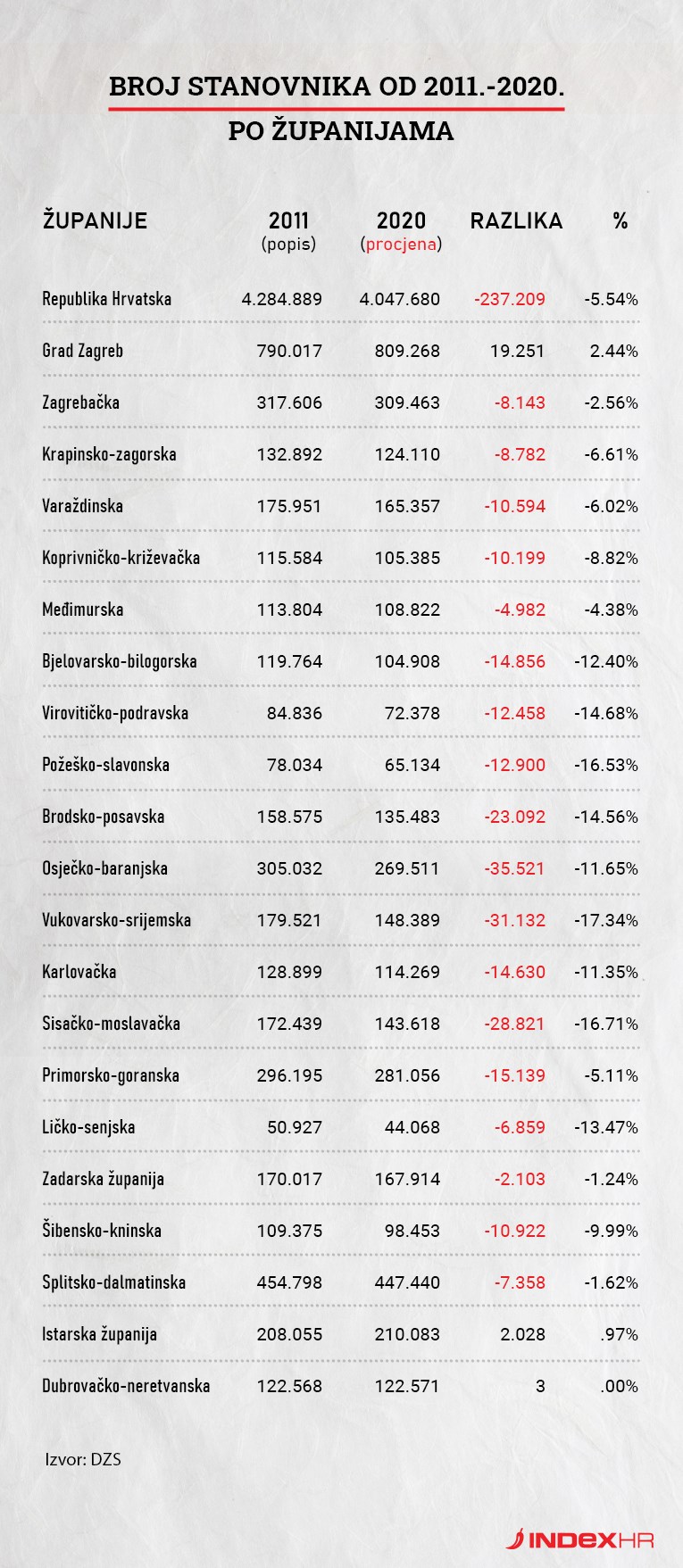October 25, 2021 - The Central Bureau of Statistics has published an estimate of the number of inhabitants by cities, municipalities and counties at the end of 2020. An estimate which says that Croatia has 237,000 fewer inhabitants than 2011, reports Index.hr.
According to the CBS, at the end of 2020 Croatia had about four million and 48 thousand inhabitants, which is about 237 thousand less than in the last census in 2011.
Only three counties have an increase
In ten years, Croatia has lost about five percent of its population. In other words, it lost every twentieth inhabitant.
Only three counties have seen population growth since the last 2011 census. This is the City of Zagreb, where a little more than 19,000 more people live compared to ten years ago, while Istria and Dubrovnik-Neretva also recorded an increase, but almost insignificant. In Istria, the population increased by slightly more than two thousand, while in Dubrovnik-Neretva it increased by about three people.
Eastern Croatia hardest hit
Eastern Croatia suffered the greatest losses. Overall, Osijek-Baranja County lost the most, with 35,521 fewer people now than in the previous census, while Vukovar-Srijem County experienced the biggest drop in population, losing more than 17 percent of its population.
Among the counties with higher losses are Sisak-Moslavina (-16.7 percent) and Požega-Slavonia (-16.5).

Rijeka lost the most people, looking around the cities
Depopulation has affected cities on the Adriatic coast.
Rijeka lost the most because it lost more than 14,500 inhabitants in the period under review. It is followed by Split with a deficit of about 10 thousand inhabitants and Osijek, which has 7650 people less than 10 years ago.
Looking at the relative picture, the biggest losers are cities from eastern Croatia. Vukovar leads with a lost fifth of the population. Among the biggest losers are three other Slavonian cities - Požega, Slavonski Brod and Đakovo.
The largest cities in Sisak-Moslavina County were also affected. Petrinja lost just over 18 percent of its population, while Sisak and Kutina lost more than 10 percent.

Solin, Kaštela, Dubrovnik and Sveta Nedelja have the highest relative growth
The largest relative increase in the number of inhabitants among the 30 largest cities was recorded in Solin (+11.6 percent), and a significant jump was achieved by Kaštela (+5.95), Dubrovnik (+4.88) and Sveta Nedelja (+4.08 percent).
We will see the true demographic picture of Croatia at the end of this year, when the results of the current 2021 census are expected.
How does the CBS calculate the population estimate?
The CBS has published on its official website the methodology for calculating the population estimate.
"Sources of data for estimating the population of the Republic of Croatia are the following surveys: Census of population, households and dwellings 2011, statistics of births, statistics of deaths, statistics of internal migration of the population, statistics of external migration of the population.
Population estimates include all persons included in the total population of the Republic of Croatia by the 2011 Census of Population, Households and Dwellings, all persons born and registered in the State Register of Births in the period from 1 April 2011 to the date of the estimate, all persons who died and were registered in the State Register of Deaths in the period from 1 April 2011 to the date of assessment and all persons who moved from abroad or emigrated abroad as well as persons who moved within the Republic of Croatia in the period from 1 April 2011 until the date of the assessment, " the explanation reads.


